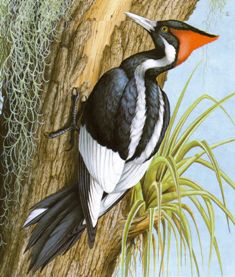Florida's Endangered and Threatened Birds.
With so many birds flying in the beautiful Florida sky, its sometimes easy to forget that some of our birds are threatened and even endangered. Woods storks are one of those endangered birds. Wood storks are tall, white denizens of freshwater or brackish wetlands
and swamps. They can be identified by their long legs, featherless
heads, and prominent bills. These waders feed on minnows in shallow
water by using their bills to perform a rare and effective fishing
technique. The stork opens its bill and sticks it into the water, then
waits for the touch of an unfortunate fish that wanders too close. When
it feels a fish, the stork can snap its bill shut in as little as 25
milliseconds—an incredibly quick reaction time matched by few other
vertebrates. A large, white, bald-headed wading bird of the southeastern
swamps, the Wood Stork is the only stork breeding in the United States.
Its late winter breeding season is timed to the Florida dry season when
its fish prey become concentrated in shrinking pools.
One of the most beautiful birds in Florida is the Roseate Spoonbill and although not threatened it is a species of special concern. Prior to the 1850s, there were probably thousands of spoonbills along
the Gulf Coast in Texas, Louisiana and Florida. By 1920, plume hunting
and colony disturbance largely depleted the spoonbill population in the
United States.The most distinctive characteristic of the roseate spoonbill is its long
spoon-shaped bill. It has a white head and chest and light pink wings
with a darker pink fringe and very long pink legs. The roseate spoonbill
is about two and a half feet in length with a wingspan of about four
and a half feet. Both males and females have the same plumage and
coloring. The male is slightly larger than the female and its bill is a
little longer. The roseate spoonbill can be found on the coasts of
Texas, Louisiana and southern Florida. It is also found in the tropics
and in Central and South America. The roseate spoonbill lives in
mangrove swamps, tidal ponds, saltwater lagoons and other areas with
brackish water., spending lots of time in the water looking food like
small fish, shrimp, mollusks, snails and insects.
The ivory-billed woodpecker is among the world’s largest woodpeckers but that hasn't protected it from being endangered. The Ivory-billed Woodpecker is one of several species whose numbers have dwindled to the point where it is uncertain whether any remain. The species is listed as critically endangered and possibly extinct by the International Union for Conservation of Nature. Only the imperial woodpecker of Mexico, now thought by many to be extinct, was larger than the ivory-bill. Averaging about 20 inches in length, the ivory billed woodpecker is frequently mistaken for the smaller but similarly marked pileated woodpecker. Beetle larvae are the primary food source for ivory-bills, which are often the first woodpeckers on dying trees searching for these larvae. Ivory-bills are believed to mate for life. They share the duties of incubating their china-white eggs and raising their young. Stiff wing feathers make the ivory-bill an especially loud flyer!
The ivory-billed woodpecker is among the world’s largest woodpeckers but that hasn't protected it from being endangered. The Ivory-billed Woodpecker is one of several species whose numbers have dwindled to the point where it is uncertain whether any remain. The species is listed as critically endangered and possibly extinct by the International Union for Conservation of Nature. Only the imperial woodpecker of Mexico, now thought by many to be extinct, was larger than the ivory-bill. Averaging about 20 inches in length, the ivory billed woodpecker is frequently mistaken for the smaller but similarly marked pileated woodpecker. Beetle larvae are the primary food source for ivory-bills, which are often the first woodpeckers on dying trees searching for these larvae. Ivory-bills are believed to mate for life. They share the duties of incubating their china-white eggs and raising their young. Stiff wing feathers make the ivory-bill an especially loud flyer!




Comments
Post a Comment